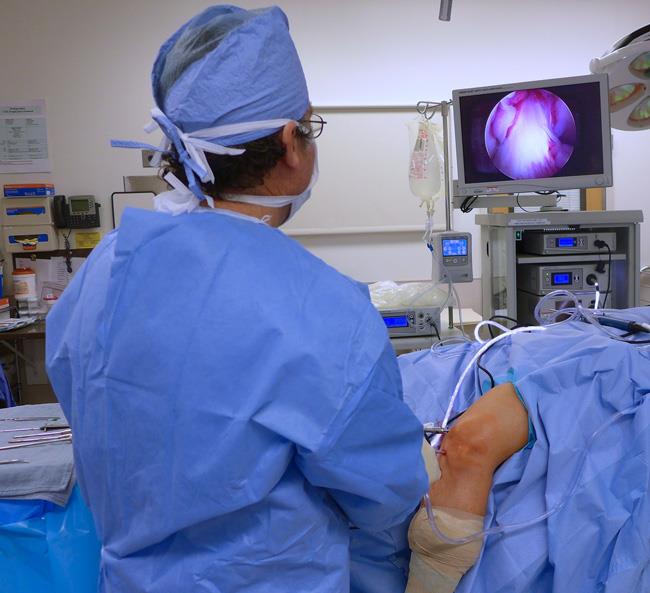Knee Replacement
Latest Treatment Photos
Total Knee Replacement under Computer Navigation
Computer-assisted total knee replacement is a procedure that utilizes sophisticated computer imaging to assure the highest level of precision during the knee replacement procedure. With the aid of a real time infrared based tracking system, we can achieve virtually perfect alignment and soft tissue balance, which are the two most critical components of a successful knee replacement. Dr.Dr.Sanagameswaran M.S. Ortho.
Total knee replacement, also called total knee arthroplasty, is a surgical procedure in which the worn out or damaged surfaces of the knee joint are removed and replaced with artificial parts. The knee is made up of the femur (thigh bone), the tibia (shin bone), and patella (kneecap). The meniscus, the soft cartilage between the femur and tibia, serves as a cushion and helps absorb shock during motion. Arthritis (inflammation of the joints), injury, or other diseases of the joint can damage this protective layer of cartilage, causing extreme pain and difficulty in performing daily activities. We may recommend surgery if non-surgical treatment options have failed to relieve the symptoms.
Indications
Total knee replacement surgery is commonly indicated for severe osteoarthritis of the knee. Osteoarthritis is the most common form of knee arthritis in which the joint cartilage gradually wears away. It often affects older people.
In a normal joint, articular cartilage allows for smooth movement within the joint, whereas in an arthritic knee the cartilage itself becomes thinner or completely absent. In addition, the bones become thicker around the edges of the joint and may form bony “spurs”. All of these factors can cause pain and restricted range of motion in the joint.
Causes
The exact cause of osteoarthritis is not known, however there are a number of factors that are commonly associated with the onset of arthritis and may include:
Injury or trauma to the joint
Fractures at the knee joint
Increased body weight
Repetitive overuse
Joint infection
Inflammation of the joint
Connective tissue disorders





Diagnosis
We will diagnose osteoarthritis based on the medical history, physical examination, and X-rays.
X-rays typically show a narrowing of the joint space in the arthritic knee.
- Our knees are vulnerable to wear and tear. Cartilage is the slippery lubricant that covers your joints and lets them glide smoothly. Over time, this cartilage can wear away, particularly in the knee and hip joints that support your body. Your age, your weight, and old injuries also matter. The result is that the bones of the joints rub against each other without enough cushioning. This is called osteoarthritis (OA).
- The first sign of knee OA is often pain and stiffness. Similar to hip OA, pain is typically worse in the morning. You may find that your knee locks or buckles when you walk. Eventually, you may feel pain and have trouble flexing your knee. Kneeling or climbing stairs may make the pain worse. The knee may feel tight and swollen, and hurt at the back of the joint.
- You can relieve OA at home. First, get enough rest. While it’s important to stay active, give your joints time off when they hurt. Second, ask us about taking chondroitin and glucosamine. These supplements may help ease pain and help you move more comfortably. You can try anti-inflammatory drugs like ibuprofen (Advil, Neurofen), Diclofenac (Voltaren rapid 25, Fenac) or Naproxen sodium (Naprogesic, Naprosyn) if we say these are safe for you. Panadol Osteo is also worth a try. They can provide fast relief for mild to moderate arthritis pain.
- Viscosupplementation Hyaluronic acid injected into an arthritic joint can afford symptomatic relief of pain and stiffness in about 70% of cases provided that the OA is not bone on bone. The injections can be repeated up to 3 times for maximal effect. We currently use “Durolane” (Bioventus) which is a stabilised single injection preloaded 60ml Hyaluronic acid in 3 ml. There is some evidence that Hyaluronic acid acts to heal early cartilage lesions and slow progression of disease.
- Stem Cell Therapy Currently there is no objective evidence that the results of stem cell therapy are any better than placebo in the treatment of osteoarthritis. There is anecdotal evidence but no randomised prospective blinded studies to support this therapy. St Vincent’s Bone & Joint do participate in ongoing evaluation of this therapy but accept that at this stage the treatment is experimental and requires more study.
- Losing weight reduces pain and stiffness. Being overweight puts extra stress on your knees and hips. You may be surprised to know that every 3 kg you lose can lower your arthritis pain by as much as 20% by decreasing the load in the joint.
- Exercise helps joints work better. Keep limber and start with stretching. Low-impact exercise, such as swimming or cycling, will strengthen your joints and increase their range of motion. A physio therapist can show you exercises to strengthen the muscles that support your knees or hips. Stronger muscles can reduce the stress on your joints during everyday activities, too.
- OA of the knee or hip can make it hard to walk. If there isn’t enough cartilage lining your joint, walking might hurt. Your joint may get so stiff that you can’t bend your knee or rotate your hip. People with severe OA of the knee or hip may need a cane to walk.
- Without treatment, OA usually gets worse. As the cartilage continues to wear away, the joint may become swollen and painful. In severe cases, bone rubs directly against bone, making any movement of the joint excruciating. Even at this point, you can still take steps to slow the damage.
- Joint replacement gets rid of pain. When other things don’t provide enough relief, your GP may recommend seeing us to discuss a hip or knee replacement. Often all the joint needs replacement, which is called a total joint replacement. In certain situations, only a partial joint replacement is necessary, especially in the knee. After recovering, most people can walk more easily and are pain-free.
- Rehabilitation is vital after joint replacement surgery. A rehab program includes vigorous exercises to make sure your new joint is flexible and to strengthen the muscles around it. People who stick to their rehab program have the greatest possible range of motion, meaning they can do more of the activities they used to do. All joint replacement patients continue to improve for at least 12 months, provided they keep up an exercise programme. Recovery normally takes 3 months until you are back to doing all your regular activities without discomfort.
What medications should I stop before operation?
Many tablets can cause excessive bleeding at operation so it is essential to cease taking the medication well beforehand. However, if you are taking such medication for problems with your heart or blood vessels, please ensure you discuss this us.
Stop the following one month (30 days) prior to admission:
- HRT (excluding Prednisone)
- Tamoxifen
- Arava
- Letrozole
Stop the following 5 days prior to admission:
- Alka-Seltzer, Chemgesic, Percoden
- Asasantin, Codiphen Forte, Persantin
- A.S.A. Aspirin, Cliopidogrel, Plavix
- Aspirin, Codis, Rheumat-ese
- Aspalgin, Codox, Rhusal
- Aspro Clear, Codral Forte, Solocode
- Asprodeine Soluble, Disprin, Solvin
- Astrix, Doloxene, Solprin
- Bex, Ectorin, Salicylamide
- Bufferin, Ensalate, SRA
- Cartia, Iscover, Vincents powder/tabs
- Cardiprin, Morphalgin, Winsprin
- Clusinol, Orthoxical Cold & Flu Tablets
Anti-Inflammatory Drugs
ACT-3, Clinoril, Inza, Priohexal, Aclin, Crysanal, Mefic, Prioxicam, Actiprofen, Dinac, Methotrexate, Proxen, Advil, Doloboid, Mobic, Rafen, Arthexin, Feldene, Naprogesic, Rheumacin, Arthrotec, Fenac, Naprosyn, Surgam, Brufen, Flexin, Nurofen, Tilcotil, Bugesic, Ibuprofen, Orudis, Toradol, Candyl, Indocid, Oruvail, Tri-profen, Celebrex, Inflam, Ponstan, Voltaren
Anticoagulants
Warafin/Coumarin/Marevan cease 5 days pre-op. The tablets will have to be withdrawn prior to surgery and CLEXANE injections are substituted up to the time of operation.
ANTICOAGULANT tablets will be resumed after surgery under the direction of A/Prof Neil.
Patient Experience
Your care and comfort are our top priorities. We ensure that the patients are well informed prior to every step we take for their benefit and their queries are effectively answered.
Latest Technologies
The Sangam Bone and Joint Hospitals’ team stays up to date on the advancements in medical procedures and technologies. Experience the Future Healthcare Technologies now at Sangam Bone and Joint Hospitals.
Providing Quality Care
Strengthening lives through compassionate care, innovative therapies and relentless efforts. It relentless efforts. It reflects in the DNA of our passionate team of doctors and dedicated clinical staff.











